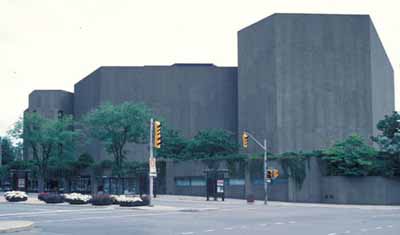National Arts Centre National Historic Site of Canada
Ottawa, Ontario

General view
© Agence Parcs Canada / Parks Canada Agency, W. Duford.
Address :
53 Elgin Street, Ottawa, Ontario
Recognition Statute:
Historic Sites and Monuments Act (R.S.C., 1985, c. H-4)
Designation Date:
2006-11-27
Dates:
-
1965 to 1969
(Construction)
Event, Person, Organization:
-
Hamilton Southam
(Person)
-
National Arts Centre
(Organization)
-
Affleck, Desbarats, Dimakopoulos, Lebensold & Sise
(Architect)
Other Name(s):
-
National Arts Centre
(Designation Name)
Research Report Number:
2005-019
Plaque(s)
Existing plaque: 53 Elgin St., Ottawa, Ontario
Designed by Fred Lebensold, the National Arts Centre (NAC) opened in 1969, offering state-of-the-art performing spaces and technology in its main venues, especially Southam Hall. Its acoustics and overall design, including its integration into the urban setting, dramatic succession of interior spaces, and incorporation of contemporary works of art, make it an outstanding performing arts centre. Hailed as an important national institution by former Prime Minister Lester B. Pearson, the NAC exemplifies the positive impact of federal support for the performing arts in the second half of the 20th century.
Description of Historic Place
The National Arts Centre is a complex structure of irregular plan whose design is based on the triangle and hexagon, from the overall composition down to decorative details. The building houses several performance spaces, rehearsal halls, dressing rooms, a workshop and prop room, offices, restaurants, reception spaces and subterranean parking garage. Designed in the Brutalist style, the National Arts Centre is constructed of poured reinforced concrete and covered with precast panels of exposed Laurentian-granite aggregate concrete with a variety of textures. The visually dominant components of its irregular design are the three main performing spaces that rise above a series of terraces.
Heritage Value
The National Arts Centre was designated a national historic site of Canada because: it is an outstanding example of a performing arts centre in Canada for its overall design, its highly successful integration into its urban setting, its succession of interior spaces to create dramatic effect, its unique combination of performing spaces and the progressive designs of each one, and its integration of contemporary works of art as part of its design; it is an outstanding example of a building illustrating the positive consequences of Canadian federal policy on the performing arts during the second half of the 20th century, considered, in the words of Prime Minister Lester B. Pearson, as a "national institution"; it is an example of state-of-the-art performing spaces and technology at the time of construction, in particular for the aesthetic and technical design of Southam Hall, which is an exceptional example of a medium-sized multi-purpose auditorium representing an inspired collaboration between architect and acoustician.
The National Arts Centre was both a major cultural as well as a major architectural achievement for the country. The structure, built in 1965-69 to designs by the architectural firm of Affleck, Desbarats, Dimakopoulos, Lebensold and Sise, reflects the rise of state support to the arts in the second half of the 20th century. It was built as part of the celebrations of for the one-hundredth anniversary of Confederation, and it was intended to herald the cultural achievements of the nation in the fields of the performing arts. The National Arts Centre is also a component of the Confederation Square National Historic Site of Canada.
Sources: Historic Sites and Monuments Board of Canada, Submission Report, Minutes, 2005.
Character-Defining Elements
Key elements contributing to the heritage value of this site include: its current siting, in relation to the Rideau Canal, Elgin Street, Laurier Avenue, Sapper’s Bridge, and the Confederation Square National Historic Site of Canada; its exterior volumes, composed of a pyramidal building-up of hexagonal shapes, masses which contain the interior spaces, and open terraces and planters; the open terraces, and their role as gathering areas and as linking spaces in the larger urban context; the richly treated concrete surfaces of the exterior; the interior disposition of spaces, including the performance spaces, administration and prop spaces, reception spaces, halls, and public parking; the finishing details, such as the types of wall and floor coverings, specially designed light fixtures, curtains, seating, sculptures, paintings, tapestries and other accoutrements especially designed for this building.